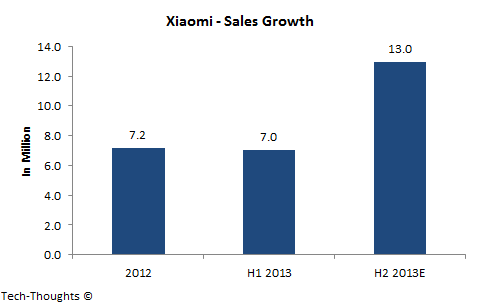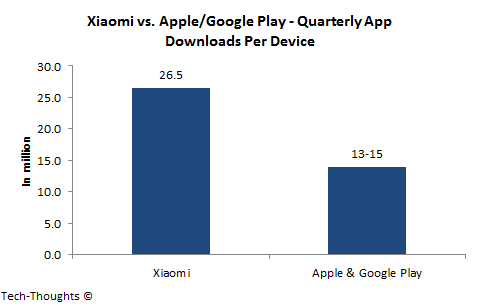

| Visitors Now: | |
| Total Visits: | |
| Total Stories: |

| Story Views | |
| Now: | |
| Last Hour: | |
| Last 24 Hours: | |
| Total: | |
Xiaomi’s Key to International Growth: Data Usage & Carriers
VP of Product Management, Hugo Barra. Hugo Barra’s new role with Xiaomi, as VP of Xiaomi Global, will be to
help guide its growth strategy in markets outside China. Let’s take a look at the key drivers of Xiaomi’s international growth prospects.
An Introduction to Xiaomi
by Lei Jun and Bin Lin, has quickly shot up the smartphone sales charts
to overtake Apple in the country. In fact, Xiaomi’s Mi 2S was said to be the
most popular smartphone in China, overtaking the Galaxy S4. In addition to
this, initial stocks of Xiaomi’s $130 “Red Rice” smartphone sold out in less
than 90 seconds and then racked up more than 7 million preorders.
Since Xiaomi’s business model is focused on services, it allows the company to
price its products slightly higher than the BOM cost. As a result, Xiaomi’s products are
priced at roughly $100-$330, far lower than competing smartphones of the same
quality. Xiaomi also uses a customized Android skin with crowd-sourced updates,
called MIUI, which is fairly popular among the developer community.
In China, a majority of Xiaomi’s smartphone sales have come from the prepaid
market. This allowed Xiaomi to use an innovative manufacturing and distribution
model – Xiaomi sells 70% of its devices online, which it manufactures in batches, and
usually sell-out in a matter of minutes. It has now begun to expand
overseas, first to Hong Kong and Taiwan, which are primarily carrier subsidized
markets. The results so far have been impressive – Xiaomi’s flagship is already
the third best-selling phone on one of Taiwan’s largest carriers, after the HTC one and the Samsung Galaxy S4.
As a result of this performance, the company recently raised funds at a
valuation of $10 billion, which is more than twice HTC’s current market value. In
short, the company’s rapid ascent has been impressive and the investing
community has great confidence in their growth prospects.
Xiaomi’s Usage & App Download Metrics
I initially thought that Xiaomi would target pre-paid
markets outside China because of their natural cost-quality advantages. That
was until I saw this statement from Xiaomi’s CEO, Bin Lin:
Xiaomi’s customers are twice as active on the mobile web as those of other manufacturers.
downloads in just 13 months and has become one of the top 5 appstores in China. Xiaomi
also announced that the MIUI appstore has 17 million active users (out of 20
million total users) and sees 5 million downloads per day. Based on this data, I was able to derive the following chart:
the fact that Xiaomi’s application base is likely to be far smaller than the
900,000 apps available on iOS and Google Play. International variants are
likely to have access to Google Play’s application base, which could
boost downloads. However, since the overall user base is still small, usage
metrics are likely to go down as their products begin to reach a larger base of mainstream
users.
Xiaomi: Competing for Carrier Attention
minimize churn rate while also minimizing subsidy costs. While this was a
challenge in the early years of the smartphone industry, the data consumption
rates across flagship devices have rapidly narrowed. In other words, flagship
smartphones are rapidly becoming “good enough” for carriers who happen to be
direct customers of smartphone OEMs.
Xiaomi’s doesn’t necessarily have to beat high-end flagships in terms of
data usage, but needs to reach comparable metrics. In other words, Xiaomi’s challenge
boils down to being “good enough” for carriers. If they can establish this
trend in subsidized markets like Taiwan & Hong Kong, it is in carriers’
interest to invest in marketing & branding their products. In addition to
the data consumption rates, carrier subsidies on Xiaomi’s devices will be a
fraction of what is paid to companies like Apple & Samsung. Even in a
financed smartphone distribution model (like T-Mobile’s), the low acquisition
cost and high quality is likely to appeal to consumers, if the carrier puts
sufficient marketing muscle behind it. Carrier marketing funds are currently
allocated to leading flagships because of contractual obligations and a lack of
appealing options. This is likely to change going forward as bargaining power
shifts back to the carriers, which would be favorable for companies like
Xiaomi.
Xiaomi’s next target market is rumored to be Europe. We may soon find out just
how effective this strategy will be.
Source: http://www.tech-thoughts.net/2013/09/xiaomi-international-growth-data-usage-carriers.html




